The Ultimate New Zealand Soccer Website | home
The Best | Coxy Goals
The Best
MICHELE COX -
Quite Simply, The Best
by Jeremy Ruane
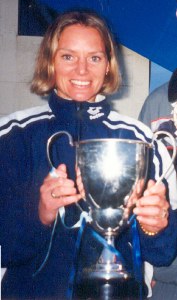 November 19, 1997, will always have special significance for Michele Cox. It marked the end of her six-and-a-half year absence from New Zealand's national women's soccer team. November 19, 1997, will always have special significance for Michele Cox. It marked the end of her six-and-a-half year absence from New Zealand's national women's soccer team.She had last donned the white jersey on May 21, 1991, in New Zealand's World Cup qualifier against Papua New Guinea in Sydney. But when it came time for then national coach Dave Boardman to name his squad for the World Cup Finals in China, the highly talented twenty-two-year-old was a notable omission from the touring party.
"In a way, it wasn't as great a disappointment to me as it could have been", reflects the midfield general. "I half expected not to be included after being left out of the squad participating in the warm-up series against Australia, and the way things went in the qualifying campaign - I played one full match, and one as a substitute, both against Papua New Guinea".
It was around this time that Michele's relationship with the national coaching staff began to deteriorate, largely due to issues over which the player had no control. Thus four years of frustration ensued, until the appointment in 1995 of a new national coach, Maurice Tillotson.
Michele was one of twenty-five players Maurice named in his first squad, which he later reduced to eighteen for a two-test series in South Korea. You'll never guess who was one of the seven non-travelling reserves ... "Being left out of that squad was very frustrating for me. I was left thinking 'What have I got to do?'"
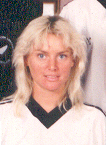 Early in 1996, the SWANZ played their first internationals on home turf for five years, but, in spite of being named Auckland's Player of the Year in 1995, there was still no sign of 'Dalglish', a nickname accorded Michele early in her career which, given the similarity of her playing style to that of the footballer Liverpool fans still hail as 'King Kenny', is most appropriate. Early in 1996, the SWANZ played their first internationals on home turf for five years, but, in spite of being named Auckland's Player of the Year in 1995, there was still no sign of 'Dalglish', a nickname accorded Michele early in her career which, given the similarity of her playing style to that of the footballer Liverpool fans still hail as 'King Kenny', is most appropriate.The players expressed their support for Michele later that year, voting her co-winner, with Wendi Henderson, of New Zealand's Players' Player of the Year, the premier accolade any footballer could wish to win.
Surely now her time had come. The opportunity for Maurice to heed the nations' female footballers' advice came sooner than expected, in a hastily arranged friendly against Papua New Guinea. Henderson, by then an established SWANZ international, was called up. So, too, was Maureen Jacobson, New Zealand's most capped international, and a former professional at HJK Helsinki and Millwall.
Due to work commitments, however, the long-time orchestrator of the SWANZ midfield was unavailable. The shortlist of potential replacements was short indeed. Only one other player in the country could satisfy the requirements of the thinking player's role which 'Jakes' had fulfilled in her previous 59 internationals.
But Michele's phone remained silent.
New Zealand's performance in that game bordered on the unbelievable, the 1-1 draw arguably the most infamous result in the history of New Zealand women's soccer. Their play lacked direction and purpose, attributes which a playmaker of Michele's capabilities would have provided in abundance.
 Maurice took on board the lessons learned from the PNG encounter, and when the SWANZ were next in action, in a tri-series against Australia and China in November, 1997, there was one squad member in particular who was quite delighted to be on the flight across the Tasman. Maurice took on board the lessons learned from the PNG encounter, and when the SWANZ were next in action, in a tri-series against Australia and China in November, 1997, there was one squad member in particular who was quite delighted to be on the flight across the Tasman."It was a tremendous surprise to be selected once again", says Cox, "after being absent from the national squad for so long. At the same time, it was quite confusing. I'd been overlooked in both 1995 and 1996, allegedly because I was 'too old'! Yet in 1997, at the age of 29, I was back in the frame".
"I was quite happy with the way I went in the tri-series", she continues. "Fitness-wise, I had no problems. And while we lost both matches (2-0 to Australia, 3-1 to China) they gave us a positive base to work from as we embarked on the road to qualifying for the 1999 Women’s World Cup Finals”.
Michele remained a key element of Maurice's plans for New Zealand's ultimately unsuccessful World Cup bid, which included the 'Champions Tour', so labelled because their six-match pre-Oceania World Cup qualifying series itinerary included two encounters against European Champions Germany and two against the then reigning Olympic Champions, the USA.
"It was a great tour", says Michele, "particularly for me, in terms of going back to Germany. But the highlight for us all was playing at RFK Stadium in front of 70,000 soccer fans, not to mention a global TV audience, as part of a unique double-header for US Soccer. That alone was a big motivation for our training endeavours, and was something I was really excited about at the time".
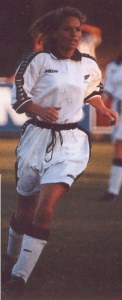 When interviewed prior to the tour, the attractive blonde didn’t even contemplate being overawed by such an occasion. "Defensively, we can play quite well, with players such as Melissa Ruscoe, Sacha Haskell, Terry McCahill and Jennifer Carlisle capable of foiling many an attack". When interviewed prior to the tour, the attractive blonde didn’t even contemplate being overawed by such an occasion. "Defensively, we can play quite well, with players such as Melissa Ruscoe, Sacha Haskell, Terry McCahill and Jennifer Carlisle capable of foiling many an attack"."Hopefully we can rely on some moments of individual brilliance to sneak results. We've got some good players who can serve us well in this regard - the likes of Donna Baker, a fellow survivor from that win in '87, Pernille Andersen and Amanda Crawford".
(Ultimately, Baker, now playing professionally in Denmark, had to forego the tour, due to injury).
Modesty sees Michele omitting herself from this game-breaking group. With the ball at her feet and a sight of goal within a range of thirty yards, however, no goalkeeper should consider herself out of the danger zone.
The beneficiary of a personal contract with Adidas threw herself head-first into her personal training programme for New Zealand's World Cup campaign, and was as fit as she had ever been going into Oceania ‘98. "It was certainly a demanding programme physically, and was comparable to the preparations for the 1991 campaign - I remember they took a lot out of me. It's not something you can do every year, that's for sure!!"
“Each member of the squad was given an individual training programme in 1997, which was specifically designed for their personal requirements in terms of readying themselves for our World Cup bid. Those programmes were reassessed in January and over Easter Weekend in 1998”.
The tournament itself went pretty much to form, with the SWANZ and Australia largely untroubled in advancing to the final, both nations notching world-record-equalling 21-0 wins in a match in their respective groups.
But the final itself was a major let-down for the host nation, who found themselves trailing by two goals inside the first thirteen minutes, an early setback from which they never recovered, eventually going down 3-1. Which means WWC 2003, in China, will most likely be Michele’s last chance to play on women’s soccer’s greatest stage.
If experience counts for anything, she should be one of the first names down on the team-sheet.
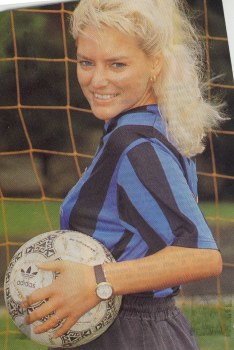 Her first real break in women's soccer came in late 1987. After making a goalscoring debut for her country in a friendly international against Western Samoa, she was part of the New Zealand squad invited to compete in a six-team tournament in Taiwan, of which more later. Her first real break in women's soccer came in late 1987. After making a goalscoring debut for her country in a friendly international against Western Samoa, she was part of the New Zealand squad invited to compete in a six-team tournament in Taiwan, of which more later.While there, she was "spotted" by watching German scouts, and was eventually signed up to play for leading German club, TSV Siegen. The experience gained from this venture alone, which included playing in the German Cup Final in front of a 70,000-strong audience, was invaluable.
"Everything in Germany was on a different level to what I was used to. The whole set-up was better, and so was the competition. At TSV, I was playing alongside top German internationals, the likes of Sissy Raith and Silvia Neid, the former captain of Germany's national team".
"There were players playing in TSV's reserve team that would have gained a place in New Zealand's national side. These girls were aged around fifteen in 1988-9, when I was there. God alone knows how good they are now!!"
"The training methods in Germany are different, too. We tend to place too much emphasis on long-distance work in a lot of our sports in New Zealand, not just soccer. Instead, we should be looking at actually playing the game in training, and working on technical attributes of the game such as heading, or the structural aspect of the game".
"The majority of training sessions in Germany revolved around using the principle tool of our trade, the football. If we had to do any athletic activities, they were done largely in the form of sprint work, the reasoning being that, during a game, soccer players do things in short, sharp bursts. The continued emphasis on long-distance work in New Zealand is detrimental to our speed in matches".
That said, Michele's no slouch when it comes to those long runs we all despise. She has been timed at 12m 13s over three kilometres, while SWANZ team-mate Maia Jackman has stopped the clock at 11m 54s. Both times compare extremely favourably with those turned in over the same distance by members of the All Black rugby team, New Zealand's most famous sporting side.
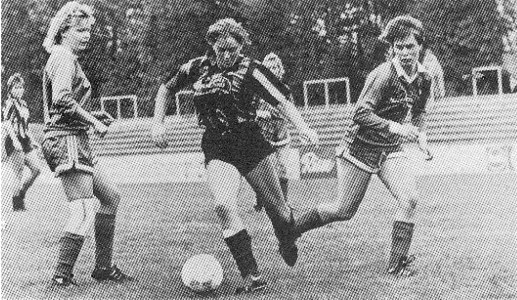 "As regards comparing the quality of competition to that in New Zealand, it's a totally different standard. We have regionalised competitions, e.g. the Northern Premier Women's League. In Germany, any of the teams playing in the top four or five divisions in the league could quite happily compete in our Premier Division. By comparison, Eden's 1987 team would be the only local club side I've played in or against which would have been competitive in Germany's top division". "As regards comparing the quality of competition to that in New Zealand, it's a totally different standard. We have regionalised competitions, e.g. the Northern Premier Women's League. In Germany, any of the teams playing in the top four or five divisions in the league could quite happily compete in our Premier Division. By comparison, Eden's 1987 team would be the only local club side I've played in or against which would have been competitive in Germany's top division".Upon returning home for the 1990 and subsequent seasons, Michele found herself playing in front of crowds numbering, at most, 150 - a far cry from those she'd been used to in Germany. Attendances at each game there numbered anywhere between 200 and the afore-mentioned 70,000.
Returning to Auckland also meant a resumption of representative duties for her province. Michele first appeared in Auckland's "A Team" in 1983, aged just fourteen. She scored on her debut from the penalty spot against Waikato in a preparatory game for that year’s National Women's Soccer Tournament. Since then, she has been part of nine National Championship-winning Auckland sides, including the record-shattering 1999 combination.
 Auckland’s 1997 triumph was made all the more special for Michele by the fact that, during the tournament, she clocked up her 100th appearance for her province, joining her mother, Barbara Cox (123) and Lyn Pedruco (110) in the 'Centurions' club. Michele, the youngest member of the group, has made 112 appearances for the “A Team”, and, with age on her side, should go on to set a tally which is unlikely to ever be surpassed. Sadly, injury, for the moment, has curtailed this prospect. Auckland’s 1997 triumph was made all the more special for Michele by the fact that, during the tournament, she clocked up her 100th appearance for her province, joining her mother, Barbara Cox (123) and Lyn Pedruco (110) in the 'Centurions' club. Michele, the youngest member of the group, has made 112 appearances for the “A Team”, and, with age on her side, should go on to set a tally which is unlikely to ever be surpassed. Sadly, injury, for the moment, has curtailed this prospect.Rather than looking on Auckland's almost unparalleled dominance of the sport in recent years as a benchmark to aspire to and, ultimately, better, however, a number of women's soccer enthusiasts south of the Bombay Hills have opted to decry Auckland's continued success, suggesting that it is detrimental to the code's growth.
As one of the key players in that ongoing success, Michele is well positioned to comment on the reasons behind it. "The mainstay of Auckland's squad down the years was, quite simply, an awesome group of players. In a lot of ways, we were very similar to Auckland's rugby team of the mid-1980s to early 1990s, in that a number of outstandingly talented players emerged at around the same time to form a great team".
"After 1991, we started going our separate ways and, consequently, the standard of women's soccer has dropped. While I mean no disrespect to the current crop of players, there is no-one around who has been able to adequately replace the likes of Wendy Sharpe and Debbie Pullen, to name just two of that great side".
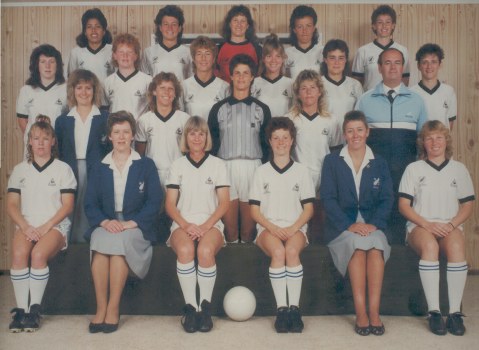 The World Women's Invitational Tournament in Taiwan in 1987 saw this side at arguably the peak of their powers. Indeed, it wouldn't be too far off the mark to regard the New Zealand women's team of the mid-to-late-80s as the best never to win a major international competition. The World Women's Invitational Tournament in Taiwan in 1987 saw this side at arguably the peak of their powers. Indeed, it wouldn't be too far off the mark to regard the New Zealand women's team of the mid-to-late-80s as the best never to win a major international competition.Michele recalls that team with pride, and well remembers one match in particular from that tournament, against a country which has gone on to set the standards in women's soccer worldwide.
"I remember standing on the sideline before our game against the USA. We were doing some stretches and generally limbering up, while our opponents were running around playing a small-sided game, and giving the general impression that we weren't going to give them any problems. This was at a time when we weren't aware of the benefits of such games as part of pre-match preparations".
"Now in those days, the USA featured a number of notable names who are still around today, the likes of Mia Hamm, Kristine Lilly and the recently retired Michelle Akers. But we were such a strong team spirit-wise that, to a woman, we vowed there and then, 'We're going to beat you'. And we did, 1-0, Alison Grant the scorer in a game which I consider to be one of the biggest highlights of my career to date".
"We didn't even contemplate losing that day", continues one of the heroines of that performance. "We just went out there and died!! On our day, that New Zealand team was capable of beating any side. Now, over ten years on, I truly believe that we can sneak a result like that once again, providing we play with the same commitment to the cause as the 1987 side did in Taiwan".
"We need to regain that mental approach in order to reassert ourselves on the international stage. The idea of running onto the pitch never thinking that we'll lose is something that's missing a little bit these days, but we showed as a squad in the tri-series in Australia that we can match it with opponents of supposedly higher ranking".
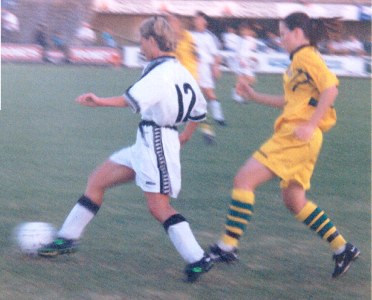 Indeed, the 2-0 loss to Australia was a result of two questionable refereeing decisions, while the margin of victory China enjoyed in their 3-1 win over New Zealand was established in the first eleven minutes, as the SWANZ came to grips with a new defensive structure which Maurice Tillotson had introduced to counter the undoubted strengths of the runners-up at Atlanta '96. Indeed, the 2-0 loss to Australia was a result of two questionable refereeing decisions, while the margin of victory China enjoyed in their 3-1 win over New Zealand was established in the first eleven minutes, as the SWANZ came to grips with a new defensive structure which Maurice Tillotson had introduced to counter the undoubted strengths of the runners-up at Atlanta '96.The goal New Zealand scored against the Chinese was the country's first in over a year, and the jubilant scorer of it has now accumulated eighteen caps for New Zealand, scoring six times.
Nearly twenty months elapsed from the end of the Oceania Women’s World Cup qualifying series until the SWANZ were next in action, but due to having undergone knee surgery, which kept her sidelined for the entire 2000 and 2001 campaigns, Michele was, once again, unable to don the silver fern.
However, the break from the game gave her the chance to tidy up her footballing CV, one which few players in this area of the world, male or female, would struggle to rival.
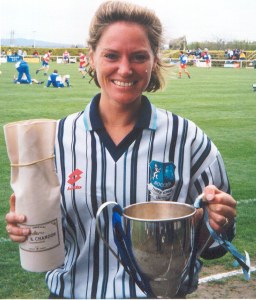 In club soccer, she has collected eight winners’ medals in both the Northern Premier Women’s League and the Auckland Premier Women’s Knockout Shield competitions, and has been a member of the Champion-of-Champions’ winners on a further seven occasions, all these honours being claimed in the colours of either Mt. Wellington, Eden, or Three Kings United. In club soccer, she has collected eight winners’ medals in both the Northern Premier Women’s League and the Auckland Premier Women’s Knockout Shield competitions, and has been a member of the Champion-of-Champions’ winners on a further seven occasions, all these honours being claimed in the colours of either Mt. Wellington, Eden, or Three Kings United.Furthermore, between 1997 and 1999, she captained Three Kings to an unprecedented three consecutive triumphs in the WSANZ National Knockout Cup, the national symbol of supremacy in women’s inter-club action.
This achievement gained arguably the greatest possible recognition at the annual Sport Auckland Sports Awards Dinner later that year, as Three Kings United’s Premier Women’s soccer team was crowned Sport Auckland’s Sports Team of the Year - soccer’s first-ever trophy at this prestigious awards ceremony, which recognises excellence in categories embracing all sports played Auckland-wide.
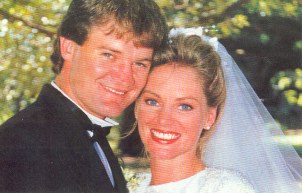 On the personal front, Michele’s efforts didn’t go unnoticed, particularly in 1998. That year, she was named New Zealand’s Player of the Year and, for a second time, Auckland’s Player of the Year. And there was just enough room in her trophy cabinet to squeeze in the Mt Roskill Sportswoman of the Year award, too! On the personal front, Michele’s efforts didn’t go unnoticed, particularly in 1998. That year, she was named New Zealand’s Player of the Year and, for a second time, Auckland’s Player of the Year. And there was just enough room in her trophy cabinet to squeeze in the Mt Roskill Sportswoman of the Year award, too!When you consider that she accomplished these feats in a year which also saw her four-year marriage to former All Black Bernie McCahill sadly end its course, one cannot help but admire her resolve in not allowing her personal upheavals to impact upon her football performances - I know my own respect for 'Coxy', great though it already was, increased still further in light of what she was enduring off the park.
If you've got the impression that Michele eats, sleeps and breathes soccer, you're very much mistaken. This footballing beauty makes a complete mockery of the 'dumb blonde' stereotype.
"I completed my Bachelor of Arts and a Diploma of Business in Marketing in 1995. Now, after a brief hiatus from my studies, I finished my Masters Degree in 1999. While studying, and training twice daily, of course (!), I was employed as a Project Manager for a number of clients, and did some sports modelling and some coaching, something which I really enjoy, and which sowed a seed for another project I‘ve since established".
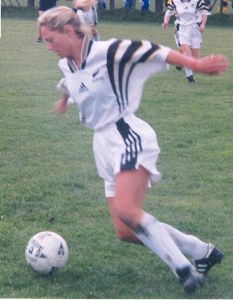 That project is the Michele Cox Soccer Academy, a coaching school focused on providing quality coaching and increased levels of competition for talented young female soccer players from around the Auckland region. That project is the Michele Cox Soccer Academy, a coaching school focused on providing quality coaching and increased levels of competition for talented young female soccer players from around the Auckland region.“Soccer is the second biggest team sport played by women in New Zealand, with 28,500 and counting active participants”, says Michele. “Since 1998, the number of registered players has increased by seventeen percent, and the game has become extremely popular with those under sixteen years of age.
“Unfortunately, the game here has taken a back seat, in terms of profile, to rival sports such as netball, hockey and cricket, primarily due to the recent successes of these national sides, the lack of depth within the game domestically, and the all-too-frequent inactivity of the SWANZ, who, in 1987, were ranked inthe world’s top four women’s soccer-playing nations, but are now ranked nearer the forty mark.
“Apart from SWANZ training camps, an annual provincial tournament and a couple of club games, international fixtures are the only occasions when talented players are pushed to the limits of their abilities. But with the sport’s limited income, and the expense of sending teams overseas due to our geographical location, international games are few and far between.
“Further compounding matters is the fact that our identification and development programmes for women’s soccer players in this country are first implemented at U-15 level, which is too late when one considers that girls overseas are receiving good quality, regular coaching by the age of ten.
The Academy is designed to help combat both these problems, particularly the second issue, by offering elite young female footballers sport-specific training at a much earlier age, the objective being to help New Zealand regain the international standing it once held in women’s soccer.
Michele is delighted with the response to her idea, with the “Course Full” signs having been posted very early on in the piece, such was the demand for places in the Academy, which has the financial support of the Lion Foundation and Placemakers Mt. Wellington, and offers the opportunity for two girls to be granted soccer scholarships at Stanford University.
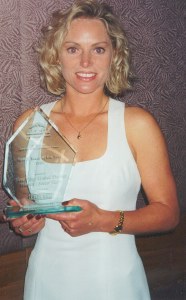 The lady who considers her family and FIFA's Technical Director of Coaching in Oceania, Kevin Fallon - "an awesome coach who made everything interesting during training, and who continues to be a good source of motivation" - to be the main influences on her career, got back into the swing of things in 2002, giving herself a full season in regional league competition to ensure that the corrective surgery necessary to return her knees to full working order. The lady who considers her family and FIFA's Technical Director of Coaching in Oceania, Kevin Fallon - "an awesome coach who made everything interesting during training, and who continues to be a good source of motivation" - to be the main influences on her career, got back into the swing of things in 2002, giving herself a full season in regional league competition to ensure that the corrective surgery necessary to return her knees to full working order. It’s a fair indication as to the state they were in, a result of the wear and tear of twenty-five years of pounding round football pitches at home and abroad, that it’s taken two years out of her career to get things back to something approaching normal.
Then again, if the powers that be deem it unwise for Michele to return to top-level action, she will have finished her career on an outstanding note, when one considers the final two trophies she collected as Three Kings’ captain - the SWANZ Cup, for a record third straight year, and the Sport Auckland Sports Team of the Year award. Follow that!!
Whatever happens, one thing will never change - my opinion of Michele Cox. She is, quite simply, the best.
|